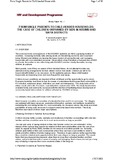| dc.description.abstract | The socio-economic consequences of the HIV/AIDS epidemic are felt in a growing number of
countries. Increasing mortality rates among adults are threatening economic and social wellbeing.
Women and children are bearing the heavy burden of nursing the sick and managing
households with over-stretched resources. Observations show that when a husband dies of AIDS
in a family, the mother is also often living with HIV/AIDS and dies shortly thereafter, leaving
children as orphans.
Most parents, even if they are aware of their terminal illness, do not attempt to make any
alternative living arrangements for their children before their death. Children are left in the
household with limited, or no, resources. As the epidemic spreads, these child-headed
households are becoming more and more frequent in rural areas.
Children in such conditions are deprived of their childhood and the opportunity to go to school.
Economic hardships lead them to look for means of subsistence that increase their vulnerability to
HIV infection, substance abuse, child labor, sex work and delinquency. This study looks at the
status, needs and skills of orphans, especially those orphaned by AIDS. The study documented
available family and community resources with the intention of facilitating future development of
community-based interventions for children affected by HIV/AIDS in Kenya. | en_US |

